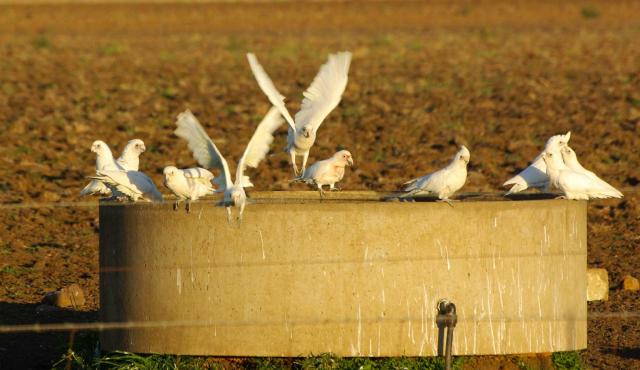A range of teacher professional learning programs will be developed to accompany the Biodiversity of the Western Volcanic Plains online outreach...




Long-billed Corella
Cacatua tenuirostris
Breeding season extends from July through to December. These birds form monogamous pairs. Nests in hollows high in tall Manna Gums or Sugar Gums or in the cavities of loose gravelly cliffs. Both parents prepare the nest and incubate 2-4 eggs for 25 days. Both parents feed the young.
| Details | Description |
| Type | Bird |
| Group | Cockatoo |
| Identifying Characteristics | |
| Distinctive Markings | Long upper mandible to the bill. Orange-red splashes on forehead and throat and an orange crescent across the upper breast. |
| Diet | Omnivore. Predominantly grass seeds, particularly from grain crops. Also feeds on bulbs and roots from the weed onion grass (Romulea rosea) and Native Murnong. 90% of their food now comes from introduced food plants. Insects are also eaten. |
| Habitat | Grassy woodland and grasslands, pasture and crop areas and urban parks. Never far from water. |
| Native Status | Native to Australia |
| Sounds | Flight call is a wavering, nasal "ar - aer - ek, ar - aer - ek". When disturbed, very loud, harsh screeches. |
| Taxonomy | |
| Phylum | Chordata |
| Class | Aves |
| Order | Psittaciformes |
| Family | Cacatuidae |
| Genus | Cacatua |
| Species | tenuirostris |

Distribution maps indicate current and historic locations where species have been sighted.
Source: Atlas of Living Australia
| Conservation Status | |
| DEPI Advisory List | Not listed |
| FFG Act | Not listed |
| EPBC Act | Not listed |
The conservation status of species is listed within Victoria and Australia.
The Department of Environment and Primary Industry (DEPI) Advisory List consists of non-statutory advisory lists of rare or threatened flora and fauna within Victoria.
The Flora and Fauna Guarantee Act 1988 (FFG Act) lists threatened species in Victoria. Under the Act, an Action Statement is produced for each listed species.
The Environment Protection and Biodiversity Conservation Act 1999 (EPBC Act) is the Australian Government’s key piece of environmental legislation, listing nationally threatened native species and ecological communities.



